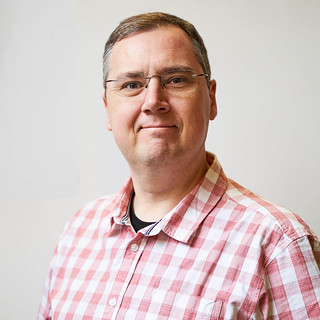Philip Fletcher Senior Instrument Specialist - Electron Microscopy
Philip is the Imaging Facility leader, overseeing the electron microscopy, X-ray analysis and molecular spectroscopy instruments, providing advice and training.
Role
Philip is the Imaging Facility leader and jointly manages the scanning electron microscopy (SEM), field emission scanning electron microscopy (FE-SEM), transmission electron microscopy (TEM), Raman spectroscopy, Fourier transform infrared spectroscopy (FTIR) and X-ray analysis instrumentation within the Imaging Facility.
He gives expert advice and support on issues relating to the instrumentation, and contributes to user training and maintenance of the equipment, and occasionally lectures in the area of electron microscopy and X-ray nanoanalysis. He is also involved in consultancy activities for external customers, enabling them to access these specialist techniques for their research.
Publications
Career
Prior to joining the University of Bath in 2015, Philip worked as an analytical chemist and museum scientist for 11 years in the Department of Conservation and Scientific Research at the British Museum, London. In this role Philip performed chemical analysis on a wide range of materials from the museum’s collections. He carried out research in the areas of object provenance, pollutant gas monitoring, salt analysis and X-ray computed tomography. He managed a multi-user SEM/microanalysis facility, and developed bespoke software for instrument control, statistical and data analysis, and data visualisation. Philip also oversaw, trained and supervised users on various other techniques, including ion chromatography, FTIR microscopy, and UV/vis, near IR and FTIR spectroscopy.
Before joining the British Museum, Philip worked as a postdoctoral researcher at the University of Pretoria in South Africa for two years. His research focused on the automation of chemical methods using sequential injection analysis (SIA), writing software for instrument control, data analysis, and chemometrics for large sets of UV/visible diode array spectrometric data.
Education
Philip’s background is in analytical chemistry. He graduated with a BSc (Hons) in Chemistry from the University of York. Following this, Philip went on to study for an MSc at the University of Aberdeen, and carried out his research project on the preparation and study of arsenic trisdithiocarbamate complexes using high performance liquid chromatography (HPLC) at the Universität Siegen, Germany.
He went on to study for a PhD in Analytical Chemistry at the University of Plymouth, supported with funding from Shell Global Solutions. His research was on the determination of additives in fuels using automated flow injection analysis with chemiluminescence detection (FI-CL). This involved designing automated field deployable instrumentation to perform on-line solid phase extraction of additives in diesel fuel with FI-CL detection, optimising reaction conditions, designing electronics to interface pumps, valves and detectors, and writing control and data analysis software.

